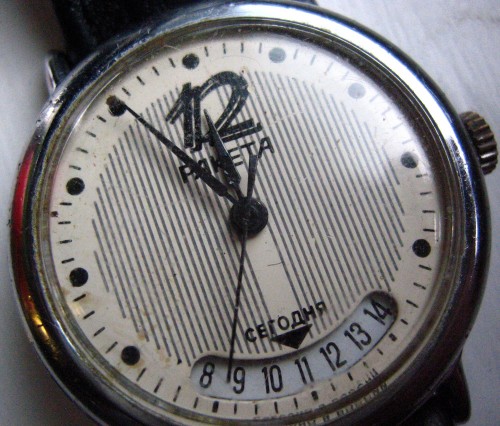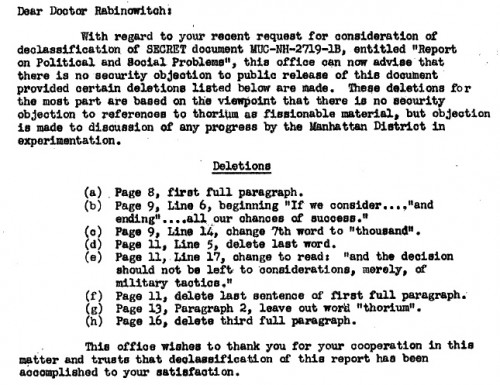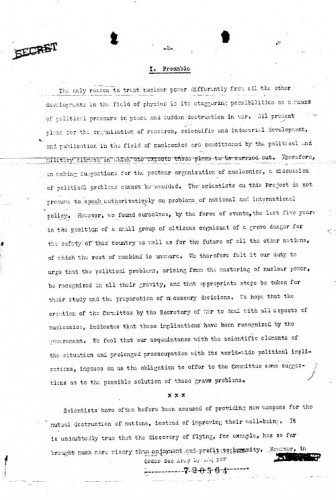
It’s official: it’s five minutes to midnight again. I wasn’t surprised to hear it. In honor of the changing of the clock, and the attempts by scientists to make weighty issues public, I thought I would go back to a classic document from the pre-history of the Bulletin of the Atomic Scientists: the Franck Report. 1
The Report of the Committee on Political and Social Problems, chaired by James Franck, is a classic of the nuclear age. Completed by scientists at the Chicago Metallurgical Laboratory just prior to the testing of the first atomic bomb, the Franck Report argued against the use of the bomb on an occupied city (instead arguing that it should be used as a “demonstration” first), warned of the perils of a nuclear arms race and proliferation, and argued that keeping the bomb a secret in peacetime was going to be futile.
Where things get complicated is how a report like this — classified “SECRET” when written during the Manhattan Project — gets out into the public domain. How do we know what was written, and what was said? How did it enter into the public consciousness, and when? And did it make it out complete, or silently edited by the censors?
In January 1946, Eugene Rabinowitch (one of the Franck Report authors and a co-founder of the Bulletin of the Atomic Scientists) petitioned to have the Franck Report formally declassified for public consumption, as part of the Atomic Scientists of Chicago’s campaign for a “civilian” Atomic Energy Act (the McMahon bill, as opposed to the “military” May-Johnson bill). This was back when declassification of Manhattan Project documents was still a fairly ad hoc affair, before formal procedures had been completely put into place. The officer relaying the declassification request noted that:
Inasmuch as most of the information contained in this Report has already been widely publicized, it is believed that declassification is sought in order to show that certain political and social problems were recognized and discussed by the scientists some time before the bombs were dropped.
Of note is that the Manhattan Project organization did remove a number of sentences and modify others of them. The version that was reprinted in the May 1946 issue of the Bulletin — probably the way the Report was first circulated widely — was a censored version. Eight changes to the Report were given to Rabinowitch to make in February 1946: 2
The versions floating around on the web are sometimes complete and original, sometimes not. Below is an almost complete, only slightly edited version, from the Harrison-Bundy files, with some of the edits having been made in by hand. 3 If you’re not a fan of grainy PDFs taken from microfilm, Gene Dannen has transcribed the whole thing based on the same source.
It makes for an interesting study to look at the passages that were considered too sensitive to release by the Manhattan Project organization in early 1946. These reveal much about the security concerns of the time — some of which are technical, others of which are political. They also show us what was being “left out” of the original public understanding of this document.
“From this point of view, the way in which the nuclear weapons now being secretly developed in this country are first revealed to the world appears to be of great, perhaps fateful importance.”
“If we consider international agreement on total prevention of nuclear warfare as the paramount objective, and believe that it can be achieved, this kind of introduction of atomic weapons to the world may easily destroy all our chances of success.”
That these two passages were deleted is rather striking — they are strictly political in nature. There is really no technical justification for them whatsoever. These are (a) and (b) in the list of deletions above.
“It may be very difficult to persuade the world that a nation which was capable of secretly preparing and suddenly releasing a weapon as indiscriminate as the rocket bomb and a million times more destructive, is to be trusted in its proclaimed desire of having such weapons abolished by international agreement.”
In this passage, the “million” that I’ve highlighted was changed to “thousand” by the MED censor. This is probably because it was too suggestive of the “Super” bomb (hydrogen bomb) idea. Note that this is altered in the National Archives copy above by hand. This is (c) in the list of deletions.
“It took us three years, roughly, under forced draft of wartime urgency, to complete the first stage of production of nuclear explosives — that based on the separation of the rare fissionable isotope U-235, or its utilization for the production of an equivalent quantity of another fissionable element. This stage required large-scale, expensive constructions and laborious procedures. We are now on the threshold of the second stage — that of converting into fissionable material the comparatively abundant common isotopes of thorium and uranium. This stage requires no elaborate plans and can provide us in about 5-6 years with a really substantial stockpile of atomic bombs. Thus it is to our interest to delay the beginning of the armaments race at least until the successful termination of this second stage.”
This whole passage is missing from the BAS version, but it’s not labeled for deletion in the list above. All that is listed above is the word “thorium,” as item (d). So I’m not sure if there was yet another layer of censorship applied. There are other phrasing differences in this section of the Report between the BAS version from the Harrison-Bundy version, and it’s unclear to me who made them.
“Thus, if the prospects of an agreement will be considered poor in the immediate future the pros and cons of an early revelation of our possession of nuclear weapons to the world–not only by their actual use against Japan, but also by a prearranged demonstration–must be carefully weighed by the supreme political and military leadership of the country, and the decision should not be left to military tacticians alone.”
This passage was modified where underlined to say “not be left to considerations, merely, of military tactics.” An interesting show of irritation, perhaps? (The Manhattan Project personnel did not think of themselves as being mere military tacticians.) These changes are listed as (e), in the list of deletions and changes.
On page 13 of the Report, there were two more references to thorium which have been removed as well. The fact that thorium is “fertile” — that is, you can put it into a reactor and make fissile U-233 from it — was not, I don’t think, a secret at this time. (Thorium is defined as a “source material” in the original McMahon act, so it must have been fairly understood. The fact that thorium could be an important material is discussed in brief in the Smyth Report, but not with any attention called to its being “fertile.”) The fact that the US considered thorium important, though, probably was secret. This is likely because General Groves had expended quite a lot of effort trying to lock up international thorium supplies, in secret, and considered the acquisition of fertile and fissionable ores the key to an American monopoly on the bomb (even more so than he considered secrecy to be). Anyway, the thorium removal is (g) in the above list.
“To sum up, we urge that the use of nuclear bombs in this war be considered as a problem of long-range national policy rather than of military expediency, and that this policy be directed primarily to the achievement of an agreement permitting an effective international control of the means of nuclear warfare. The vital importance of such a control for our country is obvious from the fact that the only effective alternative method of protecting this country appears to be a dispersal of our major cities and essential industries.”
I am not sure that the “vital importance” sentence was meant to be classified (it is not marked as such by hand), but it was omitted from the versions of the Report published in 1946. The “sum up” sentence was definitely marked for removal. This is item (h) in the above list, which says the “full paragraph.” In the Harrison-Bundy copy, these are actually two separate paragraphs, but if the pagination was wrong on the other copy, it could have been an error. (And you thought version control was difficult with MS Word!)
There is also one missing sentence which I have been unable to find in any published version, just following the line: “…the compelling reason for creating this weapon with such speed was our fear that Germany had the technical skill necessary to develop such a weapon, and that the German government had no moral restraints regarding its use.”
It is so heavily scratched out in the microfilm copy of the original Franck Report that I cannot see its contents, though I may try to consult the original some day to see if its contents can be figured out. This is item (f) in the above list. (So technically this is the almost-uncensored Franck Report. Bait-and-switch, much?) [UPDATE: see below.]
The fact of deletion is often more interesting than the deleted content. This is not a new observation, but it holds true. The above bits and pieces are quite banal from a modern standpoint, except for the fact that in 1946 they were considered at least a “SECRET” level of classification by the Manhattan Project censors. It’s hard to escape the idea that these were “SECRET” mostly for political reasons — the on-going attempts at both domestic and international control of atomic energy. (The McMahon Act was being hashing out in the Senate, and the Acheson-Lilienthal Committee was banging out their report on international control.)
For me, it’s also an interesting comment on our state of historical knowledge of this material. What document could be better known by nuclear historians than the Franck Report? Well, quite a few, actually, because there are multiple Franck Reports floating around, some marred by classification, others less so. And as far as I can tell, none of the versions floating around on the Internet (or cited in books, etc.) have the missing sentence indicated by point (f) above. So there’s still a blank spot in history — in this case, heavily scratched out in black ink.
UPDATE 6/16/2014: I found an original copy in the US National Archives. The crossed-out line is both crossed out there and gone over with “x”s on the type-writer — really quite a lot of effort, but I was able to figure out what it says. It appears to read: “We fear its early unannounced use might cause other nations to regard us as a nascent Germany.” The only word I am not 100% sure of is “nascent” — it is something that has an “n” in it, is about that long, also has an “ent” at the end, I think. It is pretty interesting that this sentence was removed, as it had zero security relevance whatsoever in the postwar.
- Full disclosure: I posted much of this as a comment to a post by Michael Krepon at Arms Control Wonk in June 2011. But it’s worth posting here now that I have my own blog… plus I’ve added some things.[↩]
- Source: John H. Mahoney to Eugene Rabinowitch (5 February 1946), in Harrison-Bundy Files Relating to the Development of the Atomic Bomb, 1942-1946, microfilm publication M1108 (Washington, D.C.: National Archives and Records Administration, 1980), Roll 7, Target 4, Folder 81, “Declassification of Documents.”[↩]
- Source: James Franck, Chair, “Report of the Committee on Political and Social Problems,” (11 June 1945), copy in Harrison-Bundy Files Relating to the Development of the Atomic Bomb, 1942-1946, microfilm publication M1108 (Washington, D.C.: National Archives and Records Administration, 1980), Roll 6, Target 5, Folder 76, “Interim Comittee — Scientific Panel.”[↩]





[…] War, there was actually very little debate about Hiroshima and Nagasaki. You basically had the Franck Report and the Targeting Committee; the former said, “don’t drop it,” and the latter […]
[…] it confused Truman as to the possible moral options (he was never presented with the question of whether a “demonstration” should be made, for example, or whether Japan should be given a direct warning first), and he chose one apparently […]
good job…An interesting study to look at the passages that were considered too sensitive to release These reveal much about the security concerns of the time — some of which are technical, others of which are political. They also show us what was being “left out” of the original public understanding of this document.
“It may be very difficult to persuade the world that a nation which was capable of secretly preparing and suddenly releasing a weapon as indiscriminate as the rocket bomb and a million times more destructive, is to be trusted in its proclaimed desire of having such weapons abolished by international agreement.”
[…] even went so far as to suggest, in a line that was until recently totally etched out of the historical record by the Manhattan Project censors, that “We fear […]